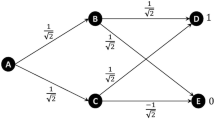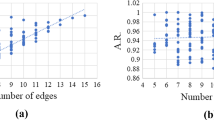Abstract
Graph search represents a cornerstone in computer science and is employed when the best algorithmic solution to a problem consists in performing an analysis of a search space representing computational possibilities. Typically, in such problems it is crucial to determine the sequence of transitions performed that led to certain states. In this work we discuss how to adapt generic quantum search procedures, namely quantum random walks and Grover’s algorithm, in order to obtain computational paths. We then compare these approaches in the context of tree graphs. In addition we demonstrate that in a best-case scenario both approaches differ, performance-wise, by a constant factor speedup of two, whilst still providing a quadratic speedup relatively to their classical equivalents. We discuss the different scenarios that are better suited for each approach.
Similar content being viewed by others
References
Aharonov, D., Ambainis, A., Kempe, J., Vazirani, U.: Quantum walks on graphs. In: Proceedings of ACM Symposium on Theory of Computation (STOC’01), pp. 50–59 (2001). http://www.citebase.org/abstract?id=oai:arXiv.org:quant-ph/0012090
Aharonov Y., Davidovich L., Zagury N.: Quantum random walks. Phys. Rev. A 48(2), 1687–1690 (1993) doi:10.1103/PhysRevA.48.1687
Ambainis, A.: Quantum lower bounds by quantum arguments. eprint arXiv:quant-ph/0002066 (2000)
Ambainis, A.: A nearly optimal discrete query quantum algorithm for evaluating NAND formulas. ArXiv e-prints (2007)
Ambainis, A., Childs, A., Reichardt, B.: Any and-or formula of size n can be evaluated in time \({n^{\frac{1}{2} + o(1)}}\) on a quantum computer. In: Foundations of Computer Science, 2007. FOCS ’07. IEEE Symposium on 48th Annual, pp. 363–372 (2007). doi:10.1109/FOCS.2007.57
Beals R., Buhrman H., Cleve R., Mosca M., de Wolf R.: Quantum lower bounds by polynomials. J. ACM 48, 778–797 (2001) doi:10.1145/502090.502097
Bennett, C.H., Bernstein, E., Brassard, G., Vazirani, U.: Strengths and weaknesses of quantum computing (1997). http://www.citebase.org/abstract?id=oai:arXiv.org:quant-ph/9701001
Boyer, M., Brassard, G., Hoeyer, P., Tapp, A.: Tight bounds on quantum searching. Fortschritte der Physik 46, 493 (1998). http://www.citebase.org/abstract?id=oai:arXiv.org:quant-ph/9605034
Buhrman, H., Cleve, R., Wigderson, A.: Quantum vs. classical communication and computation. In: Proceedings of the Thirtieth Annual ACM Symposium on Theory of Computing, STOC ’98, pp. 63–68. ACM, New York (1998). doi:10.1145/276698.276713
Childs, A.M.: Lecture 14: Discrete-time quantum walk. University of Waterloo (2011). http://www.math.uwaterloo.ca/~amchilds/teaching/w11/l14.pdf
Childs, A.M., Cleve, R., Deotto, E., Farhi, E., Gutmann, S., Spielman, D.: Exponential algorithmic speedup by quantum walk. In: Proceedings of the 35th ACM Symposium on Theory of Computing (STOC 2003), pp. 59–68 (2003)
Childs, A.M., Cleve, R., Jordan, S.P., Yonge-Mallo, D.: Discrete-query quantum algorithm for nand trees. Theory Comput. 5(1), 119–123 (2009). doi:10.4086/toc.2009.v005a005. http://www.theoryofcomputing.org/articles/v005a005
Childs, A.M., Reichardt, B.W., Spalek, R., Zhang, S.: Every NAND formula of size N can be evaluated in time \({N^{\frac{1}{2}+o(1)}}\) on a quantum computer. eprint arXiv:quant-ph/0703015 (2007)
Cleve R., Gavinsky D., Yonge-Mallo D.: Quantum algorithms for evaluating min-max trees. In: Kawano, Y., Mosca, M. (eds) Proceedings of Theory of Quantum Computation, Communication, and Cryptography (TQC 2008), pp. 11–15. Springer, Berlin (2008)
Cormen T.H., Leiserson C.E., Rivest R.L., Stein C.: Introduction to Algorithms, 2/e. MIT Press, Cambridge (2001)
Farhi, E., Goldstone, J., Gutmann, S.: A quantum algorithm for the hamiltonian nand tree. Theory Comput. 4(1), 169–190 (2008). doi:10.4086/toc.2008.v004a008. http://www.theoryofcomputing.org/articles/v004a008
Farhi, E., Gutmann, S.: Quantumcomputation and decision trees. Phys. Rev. A 58(2), 915–928 (1998). doi:10.1103/PhysRevA.58.915
Grover, L., Rudolph, T.: How significant are the known collision and element distinctness quantum algorithms? Quantum Inf. Comput. 4, 201 (2004). http://www.citebase.org/abstract?id=oai:arXiv.org:quant-ph/0309123
Grover, L.K.: A fast quantum mechanical algorithm for database search. In: STOC ’96: Proceedings of the Twenty-Eighth Annual ACM Symposium on Theory of Computing, pp. 212–219. ACM, New York (1996). doi:10.1145/237814.237866
Grover, L.K.: Quantum mechanics helps in searching for a needle in a haystack. Phys. Rev. Lett. 79, 325 (1997). doi:10.1103/PhysRevLett.79.325
Hogg, T.: A framework for structured quantum search. Phys. D 120, 102 (1998). URL http://www.citebase.org/abstract?id=oai:arXiv.org:quant-ph/9701013
Hsu F.H.: Behind Deep Blue: Building the Computer That Defeated the World Chess Champion. Princeton University Press, Princeton (2002)
Hughes B.D.: Random Walks and Random Environments, Volume 1: Random Walks. Oxford University Press, USA (1995)
Kaye P.R., Laflamme R., Mosca M.: An Introduction to Quantum Computing. Oxford University Press, USA (2007)
Kempe, J.: Quantum random walks—an introductory overview. Contemp. Phys. 44, 307 (2003). http://www.citebase.org/abstract?id=oai:arXiv.org:quant-ph/0303081
Laird J.E., Newell A., Rosenbloom P.S.: Soar: An architecture for general intelligence. Artif. Intell. 33(1), 1–64 (1987)
Moore, C., Russell, A.: Quantum Walks on the Hypercube. eprint arXiv:quant-ph/0104137 (2001)
Nayak, A., Vishwanath, A.: Quantum Walk on the Line. Technical report. DIMACS Technical Report (2000). http://www.citebase.org/abstract?id=oai:arXiv.org:quant-ph/0010117
Shenvi, N., Kempe, J., Whaley, K.B.: Quantum random-walk search algorithm. Phys. Rev. A 67(5), 052,307 (2003). doi:10.1103/PhysRevA.67.052307
Sipser, M.: Introduction to the Theory of Computation. Computer Science Series. Thomson Course Technology (2006). http://books.google.pt/books?id=SV2DQgAACAAJ
Tarrataca, L., Wichert, A.: Tree search and quantum computation. Quantum Inf. Process. 10(4), 475–500 (2011). doi:10.1007/s11128-010-0212-z
Watrous, J.: Quantum simulations of classical random walks and undirected graph connectivity. CoRR cs.CC/9812012 (1998)
Zalka, C.: Grover’s quantum searching algorithm is optimal. Phys. Rev. A 60, 2746 (1999). http://www.citebase.org/abstract?id=oai:arXiv.org:quant-ph/9711070
Author information
Authors and Affiliations
Corresponding author
Rights and permissions
About this article
Cite this article
Tarrataca, L., Wichert, A. Intricacies of quantum computational paths. Quantum Inf Process 12, 1365–1378 (2013). https://doi.org/10.1007/s11128-012-0475-7
Received:
Accepted:
Published:
Issue Date:
DOI: https://doi.org/10.1007/s11128-012-0475-7




